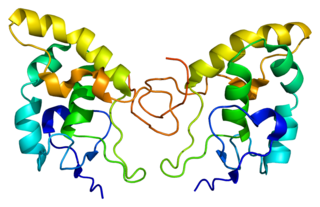The Wnt signaling pathways are a group of signal transduction pathways which begin with proteins that pass signals into a cell through cell surface receptors. The name Wnt is a portmanteau created from the names Wingless and Int-1. Wnt signaling pathways use either nearby cell-cell communication (paracrine) or same-cell communication (autocrine). They are highly evolutionarily conserved in animals, which means they are similar across animal species from fruit flies to humans.

Axin-1 is a protein that in humans is encoded by the AXIN1 gene.

Lymphoid enhancer-binding factor 1 (LEF1) is a protein that in humans is encoded by the LEF1 gene.

Proto-oncogene Wnt-1 is a protein that in humans is encoded by the WNT1 gene.

Frizzled-5 is a protein that in humans is encoded by the FZD5 gene.

Frizzled-1 is a protein that in humans is encoded by the FZD1 gene.

Frizzled-8 is a protein that in humans is encoded by the FZD8 gene.

Low-density lipoprotein receptor-related protein 5 is a protein that in humans is encoded by the LRP5 gene. LRP5 is a key component of the LRP5/LRP6/Frizzled co-receptor group that is involved in canonical Wnt pathway. Mutations in LRP5 can lead to considerable changes in bone mass. A loss-of-function mutation causes osteoporosis-pseudoglioma, while a gain-of-function mutation causes drastic increases in bone mass.

Dickkopf-related protein 1 is a protein that in humans is encoded by the DKK1 gene.

Low-density lipoprotein receptor-related protein 6 is a protein that in humans is encoded by the LRP6 gene. LRP6 is a key component of the LRP5/LRP6/Frizzled co-receptor group that is involved in canonical Wnt pathway.

Protein Wnt-3a is a protein that in humans is encoded by the WNT3A gene.

Dickkopf-related protein 3 is a protein in the Dickkopf family that in humans is encoded by the DKK3 gene.

Protein Wnt-7a is a protein that in humans is encoded by the WNT7A gene.

Sorting nexin-17 is a protein that in humans is encoded by the SNX17 gene.

Spectrin beta chain, brain 2 is a protein that in humans is encoded by the SPTBN2 gene.

Kremen protein 1 is a protein that in humans is encoded by the KREMEN1 gene. Kremen1 is conserved in chordates including amphioxus and most vertebrate species. The protein is a type I transmembrane receptor of ligands Dickkopf1, Dickkopf2, Dickkopf3, Dickkopf4, EpCAM and Rspondin1.

R-spondin-3 is a protein that in humans is encoded by the RSPO3 gene.

R-spondin 2 also known as roof plate-specific spondin-2 is a protein that in humans that is encoded by the RSPO2 gene.

Low-density lipoprotein receptor-related protein 4 (LRP-4), also known as multiple epidermal growth factor-like domains 7 (MEGF7), is a protein that in humans is encoded by the LRP4 gene. LRP-4 is a member of the Lipoprotein receptor-related protein family and may be a regulator of Wnt signaling.
Dickkopf (DKK) is a family of proteins consisting of five members as of 2020. The most well-studied is Dickkopf-related protein 1 (DKK1). DKK proteins inhibit the Wnt signaling pathway coreceptors LRP5 and LRP6. They bind with high affinity as ligands to KREMEN1 and KREMEN2, which are transmembrane proteins. DKK proteins have important roles in the development of vertebrates.



















